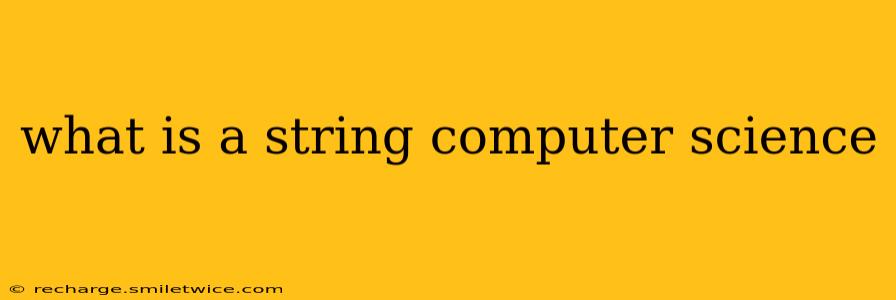In computer science, a string is a sequence of characters. These characters can be letters, numbers, symbols, or whitespace (spaces, tabs, newlines). Strings are fundamental data structures used extensively in programming for representing and manipulating text. Understanding strings is crucial for anyone working with text-based applications, from simple text editors to complex natural language processing systems.
How are Strings Represented?
Strings are typically stored in memory as arrays of characters. Each character occupies a specific memory location, and the string's length is determined by the number of characters in the sequence. Different programming languages handle string representation and manipulation slightly differently, but the underlying concept remains the same. For example, in many languages, strings are immutable – meaning once a string is created, its value cannot be changed. Instead, operations that appear to modify a string actually create a new string with the desired changes.
Common String Operations
A wide range of operations can be performed on strings, including:
- Concatenation: Joining two or more strings together (e.g., "Hello" + " " + "World" = "Hello World").
- Substrings: Extracting a portion of a string (e.g., extracting "World" from "Hello World").
- Length: Determining the number of characters in a string.
- Comparison: Comparing two strings for equality or lexicographical order (alphabetical order).
- Searching: Finding the occurrence of a substring within a larger string.
- Replacing: Substituting one substring with another.
- Case Conversion: Changing the case of characters (e.g., converting "hello" to "HELLO").
- Splitting: Dividing a string into smaller strings based on a delimiter (e.g., splitting "apple,banana,orange" into three separate strings).
Why are Strings Important?
Strings are essential because of their widespread use in numerous applications:
- Text Processing: Analyzing, manipulating, and transforming text data is a cornerstone of many applications, including word processors, search engines, and natural language processing systems.
- Data Representation: Strings are often used to store and represent various types of data, such as names, addresses, dates, and product descriptions.
- User Interaction: Strings are crucial for interacting with users, displaying messages, receiving input, and providing feedback.
- Web Development: Strings are fundamental building blocks of websites, from HTML and CSS to JavaScript and server-side scripting languages.
What Data Structures are Used for Strings?
While basic string implementations use arrays, more advanced data structures are often employed for efficient string manipulation, especially in scenarios involving large amounts of text. These include:
- Trie: A tree-like data structure used for efficient searching and prefix matching.
- Suffix Tree: A specialized tree structure optimized for substring searching.
Are Strings Mutable or Immutable?
This is a frequent point of confusion. The mutability of strings varies depending on the programming language. In languages like Python and Java, strings are generally immutable. Operations that seem to modify a string actually create a new string in memory. In contrast, some languages like C++ offer mutable string classes where the string's contents can be directly modified.
How are Strings Stored in Memory?
The specific details of how strings are stored in memory depend on the programming language and system architecture. Generally, strings are stored as a sequence of characters in contiguous memory locations, often with metadata such as the string's length. Memory management techniques, like dynamic allocation, are crucial for handling strings efficiently, especially when dealing with variable-length strings.
How Do I Work with Strings in [Specific Programming Language]?
This section would depend on the specific programming language you're interested in. For example, you could detail string manipulation in Python, Java, C++, JavaScript, etc. providing code examples relevant to that language. Each language has its own built-in functions and libraries to facilitate various string operations. You can focus on a particular language if you'd like a deeper dive on this aspect.
This comprehensive overview provides a solid foundation in understanding strings in computer science. Further exploration into specific programming languages and advanced data structures would deepen your expertise.
